
Google often modifies its logo to reflect current events and celebrate anniversaries of famous people and accomplishments. This post collects all the science- and tech-related anniversaries and events that Google celebrated with a special logo last year.
Many of these logos were only shown in one or a selected number of countries, so you have probably only seen a fraction of them.
Johann Philipp Reis
(1834 – 1874) Self-taught German scientist and inventor. He built an early telephone, today referred to as the Reis Telephone, which he demonstrated in 1861. Thomas Edison based his work on the carbon microphone on Reis’s research, and has acknowledged Reis as the first inventor of a telephone.

Shown on the Google homepage in Germany on January 7, 2009.
Inō Tadataka
(1745 – 1818) Japanese surveyor and cartographer. He is famous for completing the first map of Japan done with modern surveying techniques. It was a huge task. He spent the last 17 years of his life mapping out the entire coastline of Japan and some of its interior, spending 3,737 days doing measurements.
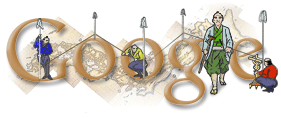
Shown on the Google homepage in Japan on February 11, 2009.
Charles Darwin
(1809 – 1882) An English naturalist. He is of course most famous for coming up with the theory of evolution and natural selection, published in his On the Origin of Species (1859).

Shown worldwide on the Google homepage on February 12, 2009.
Unix Time 1234567890
The Unix operating systems represent date and time internally with a single number, and on February 13 at 23:31:30 UTC that number ticked over to 1234567890. This was celebrated by tech geeks around the Web, including Google.

Shown worldwide on the Google homepage on February 14, 2009.
Giovanni Schiaparelli
(1835 – 1910) Italian astronomer and science historian. He is most famous for his studies of Mars, where he named the “seas” and “continents” of the planet, and the linear structures he called “canalis”, which means channels. However, the word was mistranslated to “canals” (an artificial construction instead of something natural), inspiring widespread speculation about intelligent life on Mars.

Shown worldwide on the Google homepage on March 14, 2009.
Mimar Sinan
(1489 – 1588) Chief architect and civil engineer of the Ottoman Empire (now Turkey). During 50 years he was responsible for either supervising or constructing all the major buildings in the Ottoman Empire and has more than 300 major structures credited to his name.

Shown on the Google homepage in Turkey on April 15, 2009.
Christiaan Huygens
(1629 – 1695) Dutch mathematician, astronomer, physicist, horologist as well as an early writer of science fiction. He studied the rings of Saturn, discovered Titan (one of Saturn’s moons), invented the pendulum clock, argued that light consists of waves, discovered the centrifugal force and numerous other accomplishments, including playing an important role in the development of modern calculus. Huygens is sometimes called the first theoretical physicist.

Shown on the Google homepage in the Netherlands on April 16, 2009.
Zu Chongzhi
(429 – 500) Chinese mathematician and astronomer. He pioneered a number of mathematical techniques that made it possible to construct very accurate calendars and other astronomical calculations (for example he calculated the distance to Jupiter, correctly). He made a significant number of mathematical contributions, including the closest approximation of Pi for over 900 years and a formula for finding the volume of a sphere.
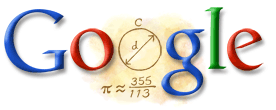
Shown on the Google homepage in China on April 20, 2009.
Tomitaro Makino
(1862 – 1957) Japanese botanist. He is often referred to as the Father of Japanese Botany and was one of the first to perform extensive classification of Japanese plants using the at the time new system created by the Swedish Carl von Linné (Carl Linnaeus). He documented over 50,000 specimens. His birthday is called “Botany Day” in Japan.

Shown on the Google homepage in Japan on April 24, 2009.
Samuel Morse
(1791 – 1872) American painter that later in life became dedicated to develop a means of rapid long-distance communication after his wife had become sick and passed away while he was away from home. He co-developed the single-wire telegraph system and Morse code, which also bears his name.

Shown worldwide on the Google homepage on April 27, 2009.
Kew Gardens, 250th anniversary
The Royal Botanical Gardens in Kew consist of 121 hectares of gardens and botanical glasshouses southwest of London, England. They contain the world’s largest collection of living plants and employs more than 650 scientists and other staff. Kew Gardens have more than 30,000 kinds of living plants and a herbarium with over seven million preserved plant specimens. It is a UNESCO World Heritage Site.

Shown on the Google homepage in the UK on May 5, 2009.
Alexander Popov
(1859 – 1906) Russian physicist. He was the first to demonstrate the practical application of electromagnetic waves and continued the research performed by other radio pioneers such as Heinrich Hertz, enabling long-distance radio communication with a radio receiver (and lightning detector) of his own creation.

Shown on the Google homepage in Russia, Ukraine and Belarus on May 7, 2009.
The Darwinius masillae fossil
Discovered in 1983 in Germany, the fossil of the Darwinius masillae that has affectionately been dubbed Ida has been dated as being 47 million years old. It’s the only one of its kind that has been found. On May 19, 2009, new findings were published that referred to Ida as “the missing link” in the primate lineage and human evolution.
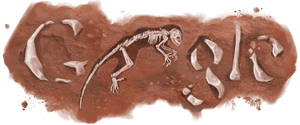
Shown worldwide on the Google homepage on May 20, 2009.
Chen Jingrun
(1933 – 1996) Chinese mathematician. He made significant contributions to number theory and is ranked as one of the leading mathematicians of the twentieth century.

Shown on the Google homepage in China on May 22, 2009.
Tetris, 25th anniversary
The video game designed and programmed by Alexey Pazhitnov in 1984. Perhaps not quite as “sciency” as the other selections we included here, but considering how iconic it was and how loved by tech geeks it is, we included it anyway.

Shown on the Google homepage in selected countries on June 6, 2009.
Nikola Tesla
(1856 – 1943) Serbian inventor and a mechanical and electrical engineer. Born in the Austrian Empire (now Croatia) he later migrated to the United States. He is one of the most famous scientists in human history, known among other things for his pioneering work with commercial electricity, electromagnetism, and numerous other discoveries.
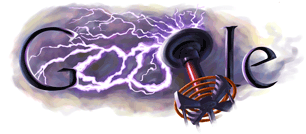
Shown worldwide on the Google homepage on July 10, 2009.
The Moon landing, 40th anniversary
On the 40th anniversary of the 1969 Apollo 11 Moon landing, Google put up this nifty logo to celebrate the first manned mission to land on the Moon.

Shown on the Google homepage in selected countries on July 20, 2009.
Hans Christian Ørsted
(1777 – 1851) Danish physicist and chemist. He is most famous for discovering that electric currents induce magnetic fields, a fundamental aspect of electromagnetism. He was also the first to produce pure aluminium, a notable contribution to the field of chemistry.

Shown worldwide on the Google homepage on August 14, 2009.
Galileo’s first telescope, 400th anniversary
Few have had a larger impact on the history of science than Galileo Galilei (1564 – 1642). He has been called the “father of modern observational astronomy,” the “father of science” and the “father of modern science”. He created what is commonly known as the Galilean telescope, which allowed him to observe the heavens with up to 30 times magnification. Galileo spent the last part of his life in house arrest by the Catholic Church since the Inquisition had found him “vehemently suspect of heresy” after he had defended the heliocentric worldview in his work (that Earth and the planets revolve around the Sun, instead of everything revolving around Earth).

Shown worldwide on the Google homepage on August 25, 2009.
Invention of the bar code
The first use of bar codes was to label railroad cars in the ‘60s. However, they didn’t really become popular until they started being used to automate supermarket checkout systems in the ‘70s. The original bar code design was inspired by Morse code, but with the lines and dots drawn out as bars.

Shown worldwide on the Google homepage on October 7, 2009.
NASA finds water on the moon
On November 13, 2009, NASA reported that they had found traces of water on the Moon (often referred to as Lunar water).

Shown worldwide on the Google homepage on November 13, 2009.
Qian Xuesen
(1911 – 2009) Chinese scientist. He made important contributions to the missile and space programs of both China and the United States.
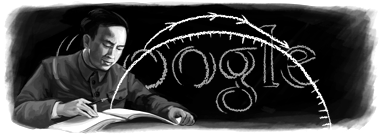
Shown on the Google homepage in China on December 11, 2009.
Discovery of the Aztec Sun Stone
Discovered and excavated in Mexico City in 1790, the large sculpture is a representation of the Aztec calendar. It measures about 3.6 meters (12 feet) in diameter and weighs 24 tons.
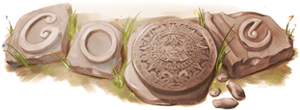
Shown on the Google homepage in Mexico on December 17, 2009.
Jan Evangelista Purkyně
(1787 – 1869) Czech anatomist and physiologist. He is most famous for his discovery of Purkinje cells (named after guess who?) in 1837. They are large neurons with lots of branching dendrites found in the cerebellum of the human brain (and look pretty much like the Google logo below). He also introduced the scientific terms plasma (blood plasma) and protoplasm.
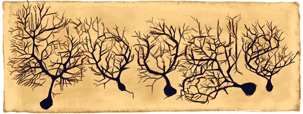
Shown on the Google homepage in the Czech Republic on December 18, 2009.
Overall, it seems that Google has really ramped up the number and variety of custom Google logos compared to previous years. These were just the ones about tech and science. You can find more over at Google’s Holiday Logos page, which is also where we found the images for this article.
Further reading: If you found this post interesting, you might want to check out 25 amazing people celebrated by Google.


























